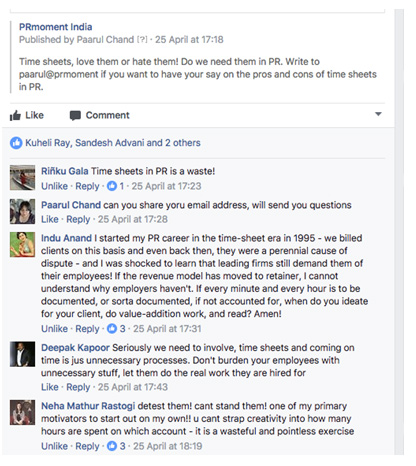Do timesheets work?
PR Insight
Timesheets. They remind me of the socially useful productive work (SUPW) notebooks one filled if you studied in a convent school. Some truth and a whole lot of leveraged truths!
Even the concept of tracking your work though a timesheet seems outdated. The challenge? What to replace timesheets with?
Against Timesheets
Radha Radhakrishnan, India country head for Gutenberg feels that, “Time sheets are an archaic way of keeping a tab on productivity and efficiency of working. It makes sense to use them where there is variability to pricing (retainer fee). For instance, if an agency works more efficiently on an activity than what is average or normal, thereby being more productive, then they get paid more. In such situations, timesheets makes sense... they can be used to substantiate productivity and efficiency aspects.”
Radhakrishnan, is however sceptical about this tabulation leading to better compensation, saying that, “ Clients seldom believe in incentivising agencies for efficient working. Hence, timesheets have just become a customary habit to fill without any substantial benefit. Also, PR is a creative industry. How do you assign accurate time to creativity?”
Rishi Bammi, independent PR consultant agrees with Radhakrishnan that, “Timesheets are definitely becoming obsolete in the fast moving PR industry. Timesheets are a real pain and they don’t even give the desired results. Individuals are forced to do it and under pressure of completing it, they fill it inaccurately.”
A post by this reporter about the pros and cons of timesheets provoked strong reactions:

Says social media and PR professional Rinku Gala, “Timesheets are obsolete. In my industry the work is more like 24 hours which the agencies do not appreciate the extra efforts put in by the employee. For e.g. In my last PR agency, i was handling a middle east airline. Now middle east has an off on Fridays and Sat, their Sunday is the 1st day of work. I've attend to all emails and clients calls on sundays and bank holidays. Also, since airlines is a crisis prone account, a PRO is expected to be on their toes at any given time. None of this is accounted in time sheets and even if there these efforts are really never given any gratification.”
Pro timesheets
Yet, there are PR professional who feel that timesheets have benefitted the PR firm.
Anand Mahesh Talari, managing director, Mavcomm says his experience with timesheets was positive. He says, “We have moved from a system where we didn't use these sheets to using these. We believe time sheet is not just a process to define time utilised on a particular client or activity but if used correctly can be a collaborative tool to increase productivity. We are therefore using a cloud based system which allows the entire team to share time sheets, collaborate and even share tasks with each other while at the same time giving seniors real time access to how the time is being deployed. “
Adds Talari, “We are seeing a significant increase in team's productivity since they have started following this system as it allows them to be more focused while helping them with notifications where required. This is helping us in pushing up the predictability quotient in PR. “
If not timesheets, what?
Radha Radhakrishnan says the alternate to timesheets depends on what is the purpose it is intended to serve. She says, “A prudent client would want to work with agencies who bring insights driven strategy to the table and not an agency that is reconciling timesheets to prove work is being executed. Clients keep pushing more for less and timesheets are definitely not an answer in this situation. They are more interested in measuring the results vs goals. I think agencies need to have smarter ways to measure results than just harping on time sheets. “
Rishi Bammi suggests using the 6 Sigma method for PR.
In this article by Mark W. McClennan senior vice president at MSL Group says that, “Reporting that the PR team called 20 reporters, conducted a special event or secured five articles does not meet management’s needs. They want to understand what business objectives those activities accomplished.”
Adds McClennan in the same article, “By applying the Six Sigma methodology to the reporting process, one agency reduced the size of a report by 45 percent, increased the amount of the report read and saved more than 10 hours each month, which translates into budget that can be assigned elsewhere. When a client or CEO sees those figures, it is hard for them to argue.”
Last word
The last word on PR timesheets has to go to PR Roast, a platform for, as the team there says,” Bringing out the inherent humour in communications Industry and there can be nothing funnier than timesheet discussions between managers and PR executives. Timesheets are absolutely necessary in our domain to keep a measure on the work we do for our prestigious clients but at the same time, creativity comes in by being out of place, a little unorganised and if we may say, a little chaotic.”
Here is PR Roast’s take on timesheets created exclusively for PRmoment India:

If you enjoyed this article, you can subscribe for free to our weekly event and subscriber alerts.
Featured

PR professionals share their views on journalists publicly calling them out on story pitches

Auto blogger renders unconditional apology to Value 360 for defamatory posts

Hottest Indian startups of 2020, Paytm, Dreams 11 lead the charge: Wizikey Report




